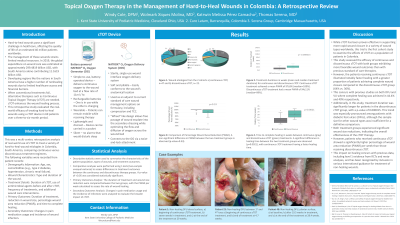Clinical Research
(CR-015) Real World Data on the Use of Topical Oxygen Therapy for the Management of Hard-to-heal Wounds: A Retrospective Review of a Colombian Patient Population
Friday, May 2, 2025
7:45 PM - 8:45 PM East Coast USA Time

Stacey Martin, PhD
Introduction: Hard-to-heal wounds pose a significant challenge in healthcare, affecting the quality of life in an estimated 40 million patients worldwide. The management of these wounds places a strain on limited medical resources. In 2019, the global expenditure on wound care was estimated at approximately 299.4819 billion USD, with South America alone contributing 11.1619 billion USD. Developing regions like South America have a higher number of cases due to limited healthcare access and financial barriers.
Methods: This was a multi-center, retrospective analysis of the real-world use of continuous topical oxygen therapy (cTOT) to treat a variety of hard-to-heal wound etiologies in Colombia, South America over a 6-month period. To better reflect real-world use, the study employed few inclusion and exclusion criteria. Patients were eligible if they were 18 years or older, diagnosed with chronic wounds regardless of their other underlying conditions such as diabetes, hypertension, or venous insufficiency, and had received cTOT. 69 patients receiving both uninterrupted cTOT and interrupted (discontinuous) cTOT were included in this study.
Results: Comparative analyses were performed using t-tests (two-sample unequal variance) to assess differences in treatment outcomes between uninterrupted cTOT and interrupted cTOT therapy cohorts. Complete healing was achieved in 64% of the uninterrupted cTOT-treated group and 36% in the interrupted cTOT-treated group, with most patients of both groups becoming pain-free after the start of treatment.
Discussion: These findings suggest that the use of cTOT as an adjunct to good standard of care can promote accelerated wound healing and reduce treatment duration and pain levels even if the therapy is interrupted. Thus, cTOT is effective in reducing the burden of chronic wounds in resource limited areas of the world such as Colombia, South America.
Methods: This was a multi-center, retrospective analysis of the real-world use of continuous topical oxygen therapy (cTOT) to treat a variety of hard-to-heal wound etiologies in Colombia, South America over a 6-month period. To better reflect real-world use, the study employed few inclusion and exclusion criteria. Patients were eligible if they were 18 years or older, diagnosed with chronic wounds regardless of their other underlying conditions such as diabetes, hypertension, or venous insufficiency, and had received cTOT. 69 patients receiving both uninterrupted cTOT and interrupted (discontinuous) cTOT were included in this study.
Results: Comparative analyses were performed using t-tests (two-sample unequal variance) to assess differences in treatment outcomes between uninterrupted cTOT and interrupted cTOT therapy cohorts. Complete healing was achieved in 64% of the uninterrupted cTOT-treated group and 36% in the interrupted cTOT-treated group, with most patients of both groups becoming pain-free after the start of treatment.
Discussion: These findings suggest that the use of cTOT as an adjunct to good standard of care can promote accelerated wound healing and reduce treatment duration and pain levels even if the therapy is interrupted. Thus, cTOT is effective in reducing the burden of chronic wounds in resource limited areas of the world such as Colombia, South America.

.jpg)